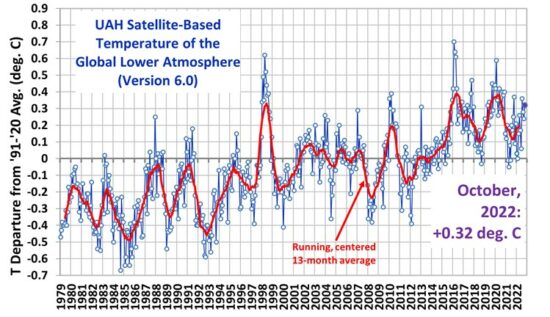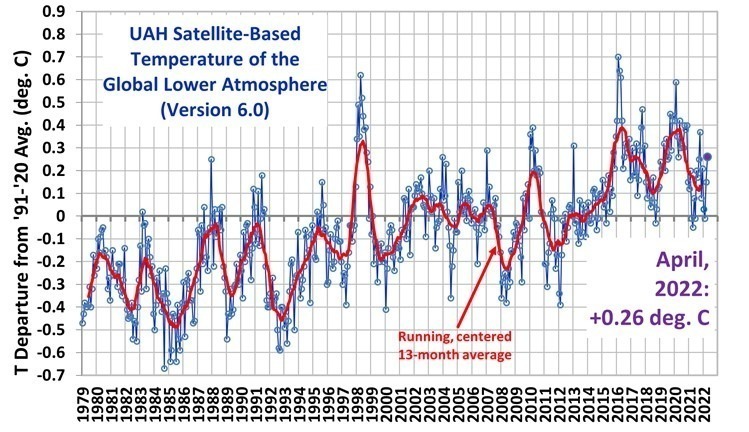Let’s break for a minute, and point out that “Climate Science” is a catch-all term, like “Sports”. The fellow who takes a daily temperature reading or measures the snow depth with a stick could call himself a “Climate Scientist” as much as the person tending the boiler in the basement could call himself a “Stationary Engineer”. Earth’s climate is an enormously complex subject, spanning not only the “pure” sciences like physics and chemistry, but many of the “natural sciences”, such as oceanography, meteorology, volcanology, paleontology, archeology, solar science, and many others. All scientists aren’t of the same quality, intellect, or natural talent for the trade. Sloppy scientists are as common as bad mechanics.
At the top of the pecking order of knowledge needs sit the fundamental laws of physics – for no matter what others may determine, the final results must obey the fundamental, established principles which determine the nature of all elemental matter. Unfortunately, many “environmental scientists” actually study very little physics, chemistry or biology in depth. And many of the “lower” sciences involve little mathematics beyond introductory calculus. Before the greater body of scientists out there start beating on us, we’ll admit that very few physicists had a time slot to study organic chemistry and beyond in college – and the truth of the matter is, there aren’t enough semester hours available for everyone to be cross-trained in other disciplines to any competent depth. This makes becoming a highly skilled “Climate Scientist” very challenging, for this extremely complex field requires a very large tool kit. Thus, we trust others to deliver meaningful results from their specific disciplines. If a geologist tells us a particular rock is from the Devonian Period, we have little choice but to believe him. So in what follows, we’re going to have to trust we have chosen good, solid scientists from other disciplines as our guide.
In reading “scientific articles” one must also be very alert to use of the word “if”. This is the killer word – the Colt .45 of sloppy or even deliberately misleading science. “If” the sea level rises 40 feet, then certainly most of Manhattan will be flooded. “If” the moon falls on Kansas, then certainly wheat prices are going to soar out of site. Within a sentence or two, “if” morphs into “when” and soon everyone is convinced that the moon is absolutely going to fall on Kansas, it’s just a matter of time, we’re all doomed… unless we take immediate action to stop it. But neither of these are very likely to happen, as we shall soon see.
After the hockey stick was accepted virtually overnight without close examination ( like the Piltdown Man ), along comes Al Gore, a long-time “environmentalist”, ( who made near-failing grades in science and math in college ) who decides to make a movie out of it. The hockey stick goes up on the big screen, and Gore boards a mechanical lift with cameras grinding, pointer in hand as he rises in unison with the blade of the stick which starts growing upward toward the ceiling. No longer are we talking about tenths of a degree, the temperature is rising like a puff pastry, and headed toward the attic. It all began with the word “if“. If the hockey stick tip continues to rise (lift starts going upward, the audience holds its breath ) then… and along comes computer animations of New York flooding, Florida underwater, and poor little Polar Bears struggling to board the last piece of ice floating in the open Arctic Sea. (sigh…) It ends with Hurricane Katrina and Boston almost losing the pennant. It is Hollywood at its finest, and the Deacons of La La Land give it an Oscar. Even the Nobel Committee is impressed, gives it two thumbs-up and a Nobel Prize to Gore and the other members of the IPCC for the many lives that will be saved in the future because of this brilliant early warning. And, there’s still time for we miserable humans to “save” the planet by buying “carbon offsets” accomplished best by investing in Al Gore’s British company which buys stock in other companies that will benefit from a world-wide global warming hysteria (keeping a healthy cut) and making, perhaps, Al Gore the richest former Vice President in history. That will buy a lot of SUV’s, jets, and large mansions with mega-electric bills. Everyone wins except the taxpayer and businessman, who are soon to pay a very heavy price.
Continued at ‘Primer 5: Solar Heating’





Don’t neglect to meitnon that wind energy is not without its downside. Its seriously ugly and is noisy. In un-inhabited areas, it works well. Ugly is OK and the noise bothers nobody. However, in some of the good windy areas, you find local residents not liking the 24 hour a day sounds, described as a “big whop-whop-whop-whop”. And its hard to sell ugly to the neighborhood.
Hi Monica,
Everything has a down side. It’s always a matter of weighing the issues.
Personally I love the windmills, aesthetically. They are things of beauty, especially compared to the vast quantities of high voltage power distribtion towers – there I see “ugly”.
I have no experience with their noise issues,and find it hard to believe that many birds are blind enough to to get hit by a slow moving blade.
These are all factors to be assessed. Sometimes criticisms are akin to saying ‘ban cars because they kill people’. That’s a silly analogy, but maybe you understand my drift.
Thanks for your comment.